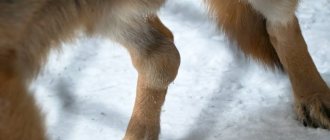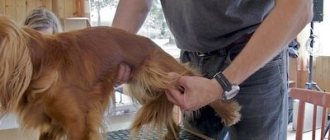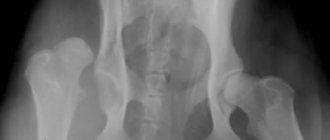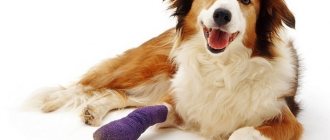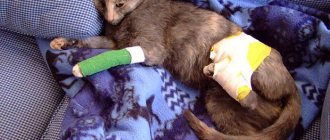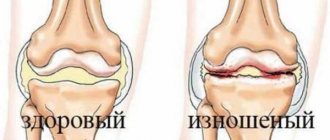Causes of bruises in dogs
The reasons are the most commonplace - falls and blows. A bruise can occur due to an unsuccessful jump - both in small dogs and large breeds. For small pets, even having to get off the couch can be a serious challenge. Large dogs have more obstacles, but the resulting injuries are the same. A common enemy of dogs is ice, which causes sudden falls and injuries.
In addition, the dog may hit something: furniture, a barrier, a collision with another animal or a vehicle. In cases with blunt objects, this can also lead to injury. It is possible to get bruises in a fight.
Sprains and bruises
Ligaments are most often affected by unsuccessful jumps or falls. The dog begins to limp, the injured joint hurts, and sometimes swells. The animal does not bend or straighten it completely; it protects its paw when walking, although sometimes it carefully leans on it. Soreness and lameness are most pronounced after waking up, then the dog “paces.”
Bruises occur when struck by blunt objects. The bruised area hurts, swells, and redness or hemorrhage may occur. The dog may limp. In most cases, you can manage sprains and bruises on your own. On the first day, cold should be applied to the damaged area for 30 minutes, with breaks of 1-2 hours: a bottle of cold water and ice, a heating pad with ice.
Over the next few days, the injured area is heated with a blue lamp or a warm heating pad, a bandage with heated salt or sand is applied for 20-30 minutes several times a day. The bruised areas can be lubricated with troxevasin twice a day. If the joint is sprained, fix it with an elastic bandage and make sure that the dog does not play, does not jump, and does not walk up the stairs. If necessary, in the first days a painkiller is given - analgin (1 tablet 2 times a day).
Symptoms of a bruise in a dog
The bruised area tends to swell due to subcutaneous hemorrhage. A hematoma occurs and bruising may occur. When you press or touch the bruised area, it hurts the dog, and she lets you know about it.
So, you can find out about the problem by the dog’s behavior. Bruises resulting from unsuccessful jumps and falls usually occur on the joints. An injured limb causes discomfort to the dog, and the animal tries to use the sore paw as little as possible. As a result, the dog noticeably limp, especially in the first hours after waking up. The damaged paw does not bend or straighten completely, and is often bent. Pets often try to alleviate their condition themselves by licking their sore spot.
If other parts of the body are bruised - usually as a result of hitting an object - a deterioration in the general condition of the animal may occur. Trauma usually affects the activity and mobility, appetite, and emotional state of the animal.
Types and stages of knee dislocations in dogs
There are several types of knee dislocations: Medal : the kneecap and tibia shift inward of the limb; Lateral : Large breeds are more prone to this type. In it, the joints of the hind limbs are turned outward. It is determined by the position of the hind legs. There are 4 stages of knee dislocation:
1) The ligament pops out of the groove. The dog lies for some time due to mild pain, but at some point it suddenly stands up or stretches its paw, and the ligament returns to its place without any crunch. The knee joint does not yet rub against the tibia.
2) The ligament moves up to 30 degrees, a crunching sound is clearly audible when walking, and also when the joint is reduced. The situation is already quite complicated, the animal is limping and trying not to step on its paw. Joint erosion may occur.
3) The ligament is constantly displaced from 30 to 50 degrees, the groove of the ligament is almost flat, the hock and knee joints are no longer parallel. The pet tries to step on the sore paw, but often lets it rest;
4) At the last stage, the groove is not just flat, it is already filled with bone tissue, the joint constantly rubs against the tibia, the angle of deviation reaches 90 degrees. Due to severe pain, the dog does not step on the damaged paw and over time it atrophies.
The main signs of the disease are swelling of the joint and the fact that the dog uses only three paws when standing up. Under no circumstances should you use the advice of neighbors and friends, or simple inspection. Lameness and swelling may be entirely due to other orthopedic conditions. As soon as you notice such signs, you should immediately contact a veterinarian and be sure to take an x-ray.
It is necessary to understand the general picture of problems with joints, but not only with the knee, but also with the hip. An x-ray will show how critical the situation is, how the cartilage and bone tissues have worn out. An x-ray should be taken in frontal and lateral projections; it will also show the degree of stretching of the joint capsule.
Types of bruises in dogs
This type of injury has its own classification according to the degree of damaging effect:
- I degree - damage to the subcutaneous tissue (soft tissue), possible damage to the skin.
- ІІ degree - damage to muscles and blood vessels. Swelling and hematomas are observed. Possible increased temperature, rapid pulse and breathing.
- III degree - serious damage affecting the skin, muscle tissue, tendons, bones, joints. Associated cracks, fractures, and dislocations are possible. Tissue necrosis. A state of shock, which can be complemented by other problems in the functioning of the nervous system - in the case of bruises to the head or spine.
- IV degree - severe violation of the structure of tissues and bones. Irreversible damage. Post-traumatic processes affect the entire body.
Bruises in dogs are also distinguished depending on the part of the body that was injured:
- bruised paw;
- head injury;
- body bruise.
Damage to a limb primarily affects the musculoskeletal system. A head bruise can result in a concussion in a dog, and a body bruise can result in injury to internal organs.
Treatment of bruises in dogs
The consequences of bruises of the first and second degrees can be easily dealt with independently and at home. Severe cases - grade III and IV bruises - require mandatory and timely contact with a veterinarian. Unfortunately, it is almost impossible to fully recover from a grade IV impact.
Basic actions in case of injury:
- provide the dog with peace;
- apply cold ice to the bruised area;
- treating the skin with iodine and an antiseptic;
- tight bandaging on the first day;
- application of anti-inflammatory ointment.
Your dog may need pain medication. Bonharen helps very well with bruises, providing a complex effect: anti-inflammatory effect, restores mobility and reduces pain, restores the filtration and production function of the synovial membrane, restores the elasticity of articular cartilage and replenishes its defects. It is administered subcutaneously or intravenously and can be used during pregnancy and lactation. Bonharen is not prescribed simultaneously with erythromycin, amoxicillin, cefquinom and other cationic antimicrobial drugs.
For severe bruises (II degree), it is recommended to apply alcohol-drying bandages for several more days and ensure the bruised area is warmed up. This is done using a blue lamp, a bandage or a warm heating pad.
A special collar may be needed to prevent the animal from licking the sore spot. This is most relevant when treating a dog’s paw bruise, as well as other parts of the body that the pet can reach with its tongue.
Types of dislocations received
A dislocation is a displacement of a joint with damage to the integrity of the tissue. The joint membrane, blood vessels, tendons and ligaments are torn. If the necessary treatment is not carried out in time, the soft tissues will not heal properly and the bones will rub against each other, and over time they may be completely worn out. Dislocations are classified as follows:
- Congenital - this deviation develops in the womb and it is almost impossible to affect the normal functioning of the limb. The dog will be absolutely healthy in all other parts of the body, active and cheerful.
- Traumatic dislocations in dogs occur as a result of a strong blow when colliding with a car, falling from a height, or running very fast;
- Pathological - occurs after an illness, when cartilage or bone tissue is weakened.
- Paralytic - appears after the death of a certain muscle group that supports the joint.
- Habitual - a dislocation of a dog’s paw that often occurs in the same place. It occurs because the muscles do not support the joint well, and once dislocated, it will periodically pop out of its shell.
- Complicated - the bone moves and can no longer return to its place. At the same time, it touches some vessels, breaking them; Tendon rupture is even possible.
- Uncontrollable - outdated, inside which new tissues and tendons have already formed in the joint.
There is also a certain classification of types of dislocations. The main ones are:
- Patella luxation in dogs.
- Dislocation of the hip joint.
Among the large number of types of this disease, luxating the kneecap is the most common. This is a displacement of the joint within the dimple of the femur. Small breeds are more susceptible to it than large individuals.
Patella luxation
There are several breeds that are very prone to luxating patellas due to their particularly small body size and thin bones. These are the Toy Terrier, Yorkshire Terrier, Chihuahua, Miniature Poodle, as well as their mixed breeds. Large breed dogs also suffer from this disease, but to a much lesser extent. This is because the bones are much thicker and the joints are much stronger.
This disease can be congenital or acquired. In a newly born puppy, it may not even be immediately noticeable. In most cases, puppies go to the vet after 4 months, and this significantly complicates treatment.
You need to figure out what kind of dislocation this is and how serious the injury is. A knee dislocation occurs when, in an abnormal position, the ligament supporting the joint becomes stretched and falls out of its socket, thus no longer supporting the joint. When healthy, this ligament prevents the joint from rubbing against the side of the thigh.
In addition to tendons, all joints also contain fluid, which lubricates the joints and makes their movements elastic. It's called synovial fluid. It turns out that the ligament itself or “patella” (its medical name) fixes the knee joint with the tibia, and the synovial fluid makes joint movements smooth and painless. When a dog’s paw dislocates, the situation radically changes and becomes more complicated. The bones begin to rub against each other, and the fluid either disappears completely, or, on the contrary, accumulates strongly in the joint and the dog begins to press its paw. And it will need to be sucked out surgically.
conclusions
The best treatment for bruises in dogs is prevention. Small dogs need to be able to jump on the sofa safely and leave it just as safely. Eliminate the possibility that the dog might escape from your hands and jump to the ground.
For large dogs, warming up before taking on high hurdles is important. And in winter, avoid walking on ice.
Remember that any bruises provoke the early development of joint problems in dogs - arthritis and arthrosis.
For the treatment of these diseases, Wellvet recommends effective drugs: Sarapin (USA), Pentosan Equin (Australia), Trocoxil (Italy) and Bonharen (Czech Republic), already mentioned for the treatment of bruises in dogs. Our consultants will help you choose the best product for your pet.
